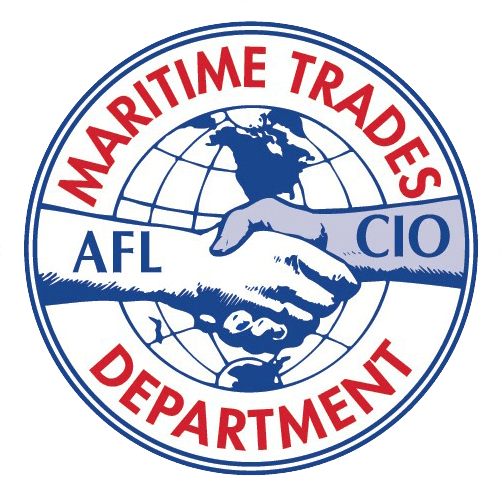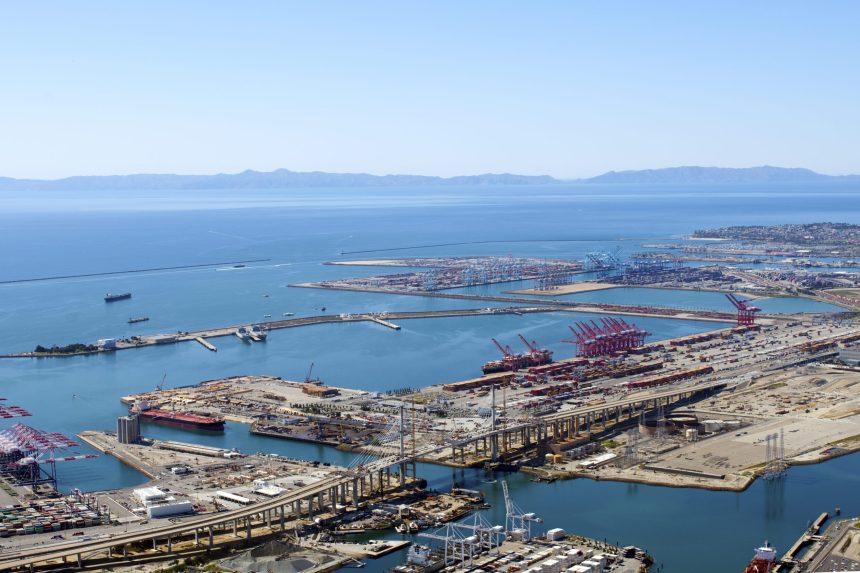The following was originally posted by the Marine Firemen, Oilers, Watertenders and Wipers Association which is affiliated with the Maritime Trades Department through the Seafarers International Union. The accompanying image appears from Don Ramey Logan for use under the Creative Commons license.
The Port of Los Angeles has been awarded $233 million in grants from the State of California to complete essential infrastructure projects aimed at creating a more efficient and sustainable supply chain. The grants were among $1.5 billion announced July 6 by California Transportation Secretary Toks Omishakin at a ceremony attended by officials from ports across Southern California.
Port of Los Angeles infrastructure projects supported by the new state grants include:
- Maritime Support Facility (MSF) Improvement and Expansion Project — The MSF provides chassis and empty container storage for all 12 container terminals at the ports of Los Angeles and Long Beach, critical to facilitating goods movement throughout the complex. With this new funding, the area will be improved and expanded from 30 to 71 acres. Improvements will include utilities, drainage, sewage, power, water supply, as well as a paved perimeter roadway. The $198.2 million total project amount includes $149.3 million from CalSTA and $48.4 million in matching funds from the Port of Los Angeles.
- Rail Mainline/Wilmington Community & Waterfront Pedestrian Grade Separation Bridge — In addition to demolition work and soil remediation, the project involves construction of a 400-foot dedicated pedestrian bridge over freight tracks, creating a safer connection between the Wilmington community, several local area schools and the Port of Los Angeles’ Wilmington Waterfront area. The project will also include construction of retaining walls, storm drainage, electrical and utilities, sidewalks and landscaping. The total project cost of $57.9 million includes $42 million from CalSTA, $5.62 million from the Port of Los Angeles and $10.2 million from LA Metro.
- State Route 47/Seaside Avenue and Navy Way Interchange Improvements — This project will modify the intersection of Navy Way and Seaside Avenue to improve traffic operations, reduce collisions and improve safety. Improvements will add a new westbound auxiliary lane, a new eastbound two-lane collector-distributor road, a new off-ramp terminal and eliminate a traffic signal, among other upgrades. Total project cost of $62.98 million includes $41.79 million from CalSTA and $21.19 million in Port of Los Angeles funds.
Additionally, the Port of Los Angeles received a $15 million grant from the California Transportation Commission for a four-lane grade separation on Terminal Island that will reduce truck delays and improve public safety.
Of the $1.5 billion awarded by the California State Transportation Agency, approximately $250 million is allocated for zero-emission infrastructure, locomotives, vehicles and vessels.
Southern California regional projects totaling $191 million were among the grants announced. These include a $100 million BNSF rail expansion project in the High Desert and another $76.3 million zero-emission rail and drayage fleet support project by the South Coast Air Quality Management District, among others. These projects support the Port of Los Angeles by improving cargo movement throughout the region.
Meanwhile, California State Transportation Agency officials announced a $383.35 million grant for the Port of Long Beach to complete a series of construction and clean-air technology projects aimed at accelerating the transformation to zero-emissions operations and enhancing the reliability and efficiency of cargo movement. As part of the state’s Port and Freight Infrastructure Program, nearly $225 million will fund a variety of zero-emissions cargo-moving equipment and supportive infrastructure projects across the Port of Long Beach, and include “top handlers” and other manually operated cargo-handling equipment, as well as tugboats and locomotives. The sum is the single largest grant the port has ever received to support the zero emissions goals of the 2017 Clean Air Action Plan Update.
Additionally, $158.4 million of the state grant will go toward the planned Pier B On-Dock Rail Support Facility, which will shift more cargo from trucks to on-dock rail, where containers are taken to and from marine terminals by trains. The $1.57 billion facility will be built in phases, with construction scheduled to begin in 2024 and be completed in 2032.
As part of its Clean Air Action Plan, or CAAP, the Port of Long Beach has set a goal of zero-emissions terminal operations by 2030, and zero-emissions trucking by 2035. The port has a long track record of air quality improvement projects that have dramatically lowered emissions since 2005. Officials hailed the grant announcement as a major step forward in the effort to continue improving the port’s sustainability — especially when it comes to air quality — and to build rail facilities needed to speed cargo to its destination.
The 2022-2023 state budget sets aside $2.3 billion for supply chain resilience, including one-time funding totaling $1.2 billion for the Port and Freight Infrastructure Program to support goods movement networks affected by the pandemic-induced cargo surge that resulted in unprecedented congestion at California’s seaports. The program’s goal is to improve the capacity, safety, efficiency and resilience of goods movement through California’s seaports, while also enhancing air quality and growing the state’s economic competitiveness.

